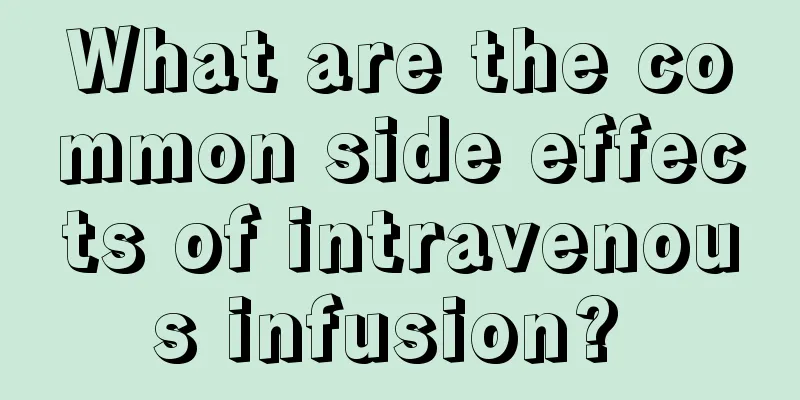What are the common side effects of intravenous infusion?

|
Intravenous infusion is an advanced treatment method. It appeared relatively late, with only a few decades of history, but it is one of the effective means for people to treat various inflammatory diseases. The method of intravenous infusion has become popular and has become a basic treatment method. However, long-term use of intravenous infusion may also cause damage to the body. Let’s take a look at the common side effects of intravenous infusion. 1. Fever reaction Clinical manifestations: During the infusion, patients may experience fever, chills, and chills. The body temperature of patients with mild fever reactions will be around 38°, while patients with severe fever reactions will experience chills in the early stages, but as the disease worsens, high fever will occur, with the body temperature as high as 40°-41°, accompanied by systemic symptoms such as headache, nausea, vomiting, and rapid pulse. Emergency treatment: 2. Acute pulmonary edema Clinical manifestations: cough, chest tightness and dyspnea, pink foamy sputum, etc. If the patient's condition is serious, sputum will flow out of the nasal cavity or mouth. When auscultating the patient's lung area, one may hear irregular heartbeat, rapid rhythm, and moist rales. Emergency treatment: 1. Stop the infusion immediately, instruct the patient to sit upright with both lower limbs hanging down, and report to the doctor on duty. 2. Give high-concentration oxygen (6-8 L/min) and add 20%-30% ethanol to the humidification bottle or use a non-invasive ventilator as prescribed by a doctor. 3. Use cardiotonic, diuretic, vasodilator, sedative and other drugs as prescribed by your doctor. 4. If necessary, perform rotational bandage on the limbs, and loosen the tourniquet on one limb every 5-10 minutes. 5. Comfort the patient's emotions. 6. Record the rescue process. 7. Strengthen inspections, observe closely, and focus on shift handovers. 3. Air Embolism Clinical manifestations: Patients may experience substernal pain or chest discomfort, dyspnea and severe cyanosis. When auscultating the patient's precordial area, a bubbling sound may also be heard. Emergency treatment: 1. Immediately turn off the infusion device, place the patient in left lateral position with the head down and feet up, and report to the doctor on duty. 2. Closely observe changes in the patient's condition and give oxygen inhalation and drug treatment as prescribed by the doctor. 3. Provide psychological care. 4. Record changes in the patient’s condition and the rescue process. 5. Focus on shift handover. IV. Phlebitis Clinical manifestations: Cord-like red lines appear along the veins, local tissues become red and swollen, hot and painful, accompanied by systemic symptoms such as fever and chills. |
<<: What should I do if air enters my blood vessels during infusion?
>>: Can faded clothes be soaked in salt water?
Recommend
How to tighten the skin after losing weight? Three tips to help you solve it easily
Love of beauty is a woman's nature, and every...
Prevention and treatment of foodborne parasitic diseases
Foodborne parasitic diseases mainly occur in chil...
Washing down jackets in a drum washing machine
Many women like summer because the arrival of sum...
What are the methods to remove oil stains from clothes
In life, if beautiful clothes are stained with oi...
3 common symptoms of recurrence of rectal cancer after surgery
Rectal cancer is one of the most common malignant...
Common symptoms of gallbladder cancer
Most people may be familiar with gallbladder canc...
Will I lose my hair if I receive chemotherapy for uterine cancer?
Hair loss is a normal reaction after chemotherapy...
Is melanoma contagious?
Melanoma is a type of skin cancer. Is melanoma co...
How to treat lumbar vertebral compression fractures
A common cause of lumbar vertebral compression fr...
What should I do if I sprain my knee? You need to know these
Knee sprain is a very common condition in daily l...
What to do if your hair becomes deformed while sleeping
For young people, hairstyle is very important. So...
What foods should not be eaten by gout patients?
Gout patients generally suffer from a disorder in...
What are the effects of Cordyceps sinensis wine?
We all know that Cordyceps sinensis is a very pre...
It turns out that the symptoms of secretory otitis media are these 4 types
Secretory otitis media is a common ear inflammati...
The difference between pelvic floor muscle and pelvic recovery
Many people do not pay much attention to pelvic r...









